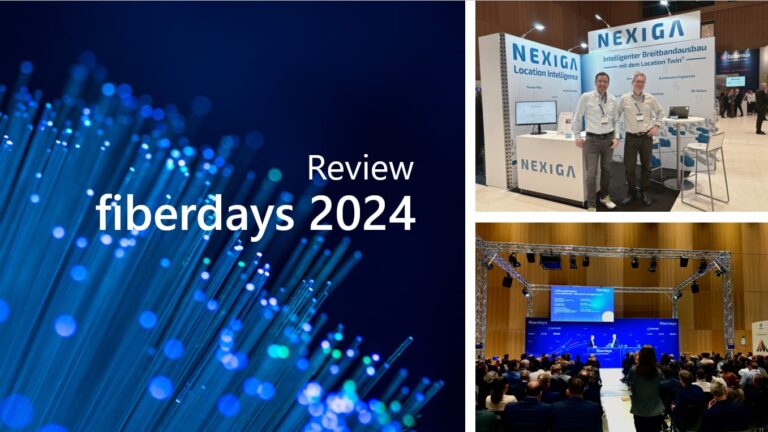A look at fiberdays 2024
Fiberdays 2024, which took place at the end of February at the RheinMain CongressCenter in Wiesbaden, is an important platform for the telecommunications industry to discuss the expansion of fibre optics and digitalization in Germany.
The trade fair offered a diverse program with top-class panel discussions on various topics. New focal points this year were sustainability, diversity and municipal expansion.
Detailed building data with stored features such as the number of households or residential units and commercial units ensure efficient and targeted expansion. Nexiga had its own stand at the event and presented geodata, which plays an important role in the strategic planning and expansion of fiber optic networks.

Stand team Nexiga from left: Dirk Lohoff, Jochen Wetzel
Solution for telecommunications
-
Site selection and prioritization
Geodata makes it possible to select strategically important buildings that should be prioritized for fibre optic expansion. This can be done on the basis of population density, commercial settlements or other criteria. -
Network planning and routing
By analysing the location of individual buildings, optimal routes for fibre optic cables can be planned in order to minimize expansion costs and maximize the efficiency of network expansion. -
Avoiding obstacles
With the help of geodata in general, potential obstacles such as trees, rivers or roads can be identified in order to plan a precise route that avoids unnecessary and expensive detours. -
Capacity planning
The number of connected buildings influences the capacity of the fiber optic network. Geodata helps to estimate the potential user base and supports capacity planning. -
Existing buildings and retrofitting
Geodata makes it possible to identify existing buildings that are not yet connected to the fiber optic network. This is important for retrofitting and expanding the network.
Building features in the Nexiga house database
Customers and interested parties from the energy sector were also represented at the trade fair.
When it comes to fiber optic expansion, the Nexiga home database provides a wide range of features for more than 21.6 million assessed buildings out of a total of more than 23.2 million identified homes. Some of these are:
- Number of households and companies per address point
- Technology scores related to households in terms of affinity to VDSL, high-tech products, etc.
- Differentiation according to telecommunication types of households with regard to equipment, planning and typical behavior patterns in the area of telecommunications
- Distance to the next cable branch at building level
- Market shares for fixed-line and mobile communications
You can find more information about the Nexiga building features here.
